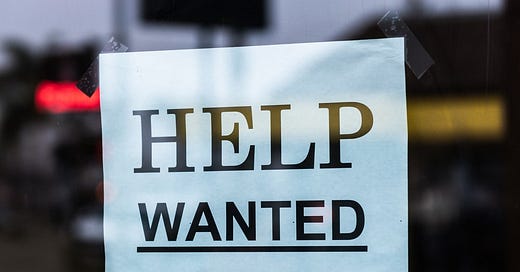A record 10.9 million jobs are available, but labor participation is lowest in decades. It will be worse.
By Gary Abernathy
Great service is a bonus, but thanks for just showing up

With statistics showing a record 10.9 million jobs available in the U.S. but the lowest labor participation rate in 40 years, it’s clear that the unnecessary decision last year to crash our economy continues to have disastrous effects.
Not only are people not returning to work after the government forced them to stay home, the Biden administration is now trying to enact a multi-trillion dollar “democratic socialist” budget bill built by none other than Sen. Bernie Sanders.
In my latest Washington Post column, I point out that…
One of the biggest incentives to work is earning enough to pay for the necessities of life and possibly something more, with the understanding that not everyone will have everything in equal measure. When the fruits of that labor are provided from the public trough in amounts far exceeding a basic social safety net, it’s only natural that fewer people will be motivated to work. Even with higher wages, it’s more difficult than ever to recruit people for unglamorous service-industry jobs.
As many of us argued at the time, and I’m still arguing in my new piece, shutting down businesses and ordering people to stay home was unnecessary and disastrous — something I point out that others like the New York Times are beginning to acknowledge.
How much did crushing our economy help to control the virus, keep hospitals from being overwhelmed or prevent deaths? We’ll never know for sure, but even media outlets of the mainstream variety are gingerly beginning to acknowledge that covid-19 seems to do what it does regardless of our response, short of a vaccine. In a story analyzing covid-19’s observable cycles, David Leonhardt of the New York Times wrote Monday that “social distancing is not as important as public discussion of the virus often imagines.” Michael Osterholm, an infectious-disease expert at the University of Minnesota, told Leonhardt, “We’ve ascribed far too much human authority over the virus.”
Passing the so-called “Build Back Better” collection of budgetary giveaways will just make things worse. In the meantime, we all should appreciate more than ever people who come to work, especially in the service industries like restaurants, grocery stores and other retail outlets. Where we once appreciated and thanked people for providing great service, now we need to thank them just for showing up — because their presence means they’re resisting government incentives to do otherwise.
You can read it here. A subscription may be required if you have exceeded the number of free views this month.
Calling GOP ‘radicalized’ ignores Democrats’ extremism
It borders on amusing reading the parade of stories claiming that the Republican Party has become “radicalized.” Writers and pundits abound who line up to declare that the GOP is no longer a political party, but instead a cult or movement posing a threat to the United States.
Examples in recent months:
“GOP embrace of extremism began long before Trump” — Hartford Courant, March 9, 2021.
“The GOP is a grave threat to American democracy” — The Atlantic, April 26, 2021.
“My front row seat to the radicalization of the Republican Party” — Los Angeles Times, June 13, 2021.
“This is exactly how radicalized House Republicans have become” — CNN, Sept. 2, 2021.
And so on and so forth. They keep coming.
As I noted last month, the Washington Post reported recently that “domestic-terrorism analysts warn that too much attention on established groups such as the Oath Keepers and Proud Boys obscures the hard-right turn of millions of conservatives, a phenomenon some have described as a ‘mass radicalization.’”
So, even “domestic-analysts” are basically claiming that conservatives — i.e. Republicans — have become “mass radicalized.”
It’s interesting who gets to define these things. What’s radical and what’s not is often a matter of debate — especially when claims of radicalization come mostly from those on the left, along with disgruntled Republicans who thought they owned the GOP before Trump came along.
But it’s frightening that the GOP is the party in the crosshairs of many people and groups inside and outside of the media for its supposed extremism when the Democratic Party is arguably the one that has more blatantly gone off the rails.
For instance, Democrats are so radically pro-choice on abortion that it’s virtually impossible for a pro-life Democrat to get elected, at least not with any support from the party. And the whole “woke” movement — which strangles free speech and thought and leads to banishment courtesy of the unforgiving “cancel culture” — is practically a registered trademark of the Democrats.
Most glaring of all is the Democratic Party’s takeover by congressional “democratic socialists” like Bernie Sanders, Alexandria Ocasio-Cortez, Rashida Tlaib, Cori Bush and Jamaal Bowman, who are essentially controlling the party’s agenda on everything from the environment to the “Build Back Better” budget, which is filled with socialist-style giveaways. The Democratic Party has long been considered the “liberal” or “progressive” party, but progressivism has given way to something far more radical — something that is on the cusp of converting the U.S. from capitalism to socialism, if it hasn’t already for all intents and purposes.
The Republican Party has things to sort out, no doubt about it. But everyone should consider carefully which party has actually become more radicalized.
Sign up or share this newsletter
Please sign up to receive this newsletter directly into your inbox or, if you are already a subscriber and reading this by email, share with a friend using the convenient button below. Thank you!


